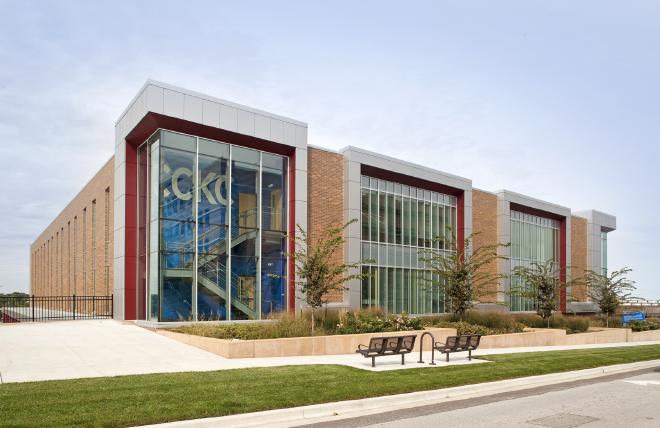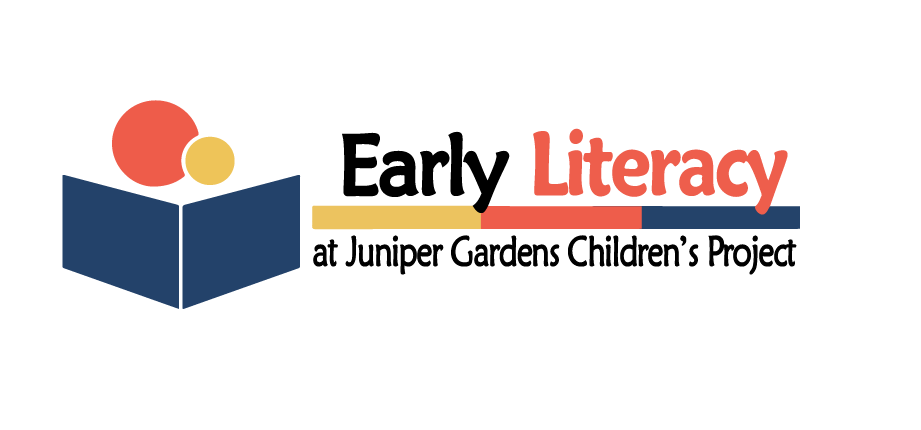History
Improving the literacy skills of children and youth in the low-income communities of Kansas City has been an uninterrupted focus of the Juniper Gardens Children’s Project (JGCP), because literacy is a stepping stone to leading to school readiness, reading achievement, and the lifelong benefits of academic success. Original work was focused on demonstrating that interventions in the home, preschool, and elementary school make a measurable difference in children’s behavior and skills (Greenwood et al., 1992). This was at a time when there was no kindergarten, Head Start, or preschool services, particularly in low-income schools. Consequently, a preschool program was established in the community center of the Juniper Gardens Public Housing Project, and local mothers operated the program.
The focus was on promoting children’s language and social behaviors using a curriculum developed by JGCP researchers. This program later moved to the Turner House Preschool, a facility for this purpose built by the local archdiocese. From this effort, important frameworks, including the Incidental Teaching of Language, was developed (Hart & Risley, 1978). This formed the basis for many contemporary naturalistic/responsive language teaching methods (Roberts & Kaiser, 2011) that could support children’s later literacy skills.

Juniper Gardens Children’s Project’s First Location

Juniper Garden Children’s Project Current Location
A tutoring program was established in the basement of a local church where children from the adjoining elementary school attended after school. Success of this program led to expansions into local schools and summer programs (Hall, Lund, & Jackson, 1968; Wolf, Giles, & Hall, 1968), which were implemented by community members, university students, and teachers. The findings were groundbreaking because this research confounded the prevailing view that the lack of academic success of persons in poverty was due to genetics and not educational experiences. There were no compelling theories of environmental influence at the time, and this JGCP work launched the first demonstration that parents and teachers using specific practices could make measurable improvements in children’s behavior, language, and achievement, now the basis for contemporary views on evidence-based practice.
From these humble beginnings, legacy accomplishments at the JGCP have included the development of Class-wide Peer Tutoring (Greenwood, 2008a; Greenwood, Delquadri, & Hall, 1989), and discovery of the 30-Million Word Gap (Hart & Risley, 1995, 1999). Class-wide Peer Tutoring became a model for including children with disabilities meaningfully in the general education curriculum (Fuchs, Fuchs, Mathes, & Simmons, 1997). The Word Gap discovery has been wake-up call to the importance of the talking to children during the birth to three period and the antecedents of literacy outcomes (Greenwood, 2008b).
The research conducted at JGCP led to changes federal policies towards prevention through greater education opportunity (e.g., Head Start, Early Head Start) and other community-based programs serving children living in poverty for the first time. This supported research on the instructional experiences of preschool-aged children to ensure vulnerable young children were better prepared to be successful in kindergarten in areas such as reading and writing.
However, even with this progress and resources, we learned that instructional interventions were successful with many but not all children for a range of reasons that included lack of early experiences and delays/disabilities among others (e.g., languages other than English). We learned that what appeared to be treatment failures for some children could be understood in terms of response to intervention, and when children were not making progress in an intervention, adaptation of the intervention was needed.
To monitor individual children’s response to intervention, we needed two dimensions of measurement for an early childhood system of adaptive intervention benefiting the full range of learners: 1) general outcome measures of growth and progress over time, and 2) observational measures of children’s engagement. Working with partners in the Early Child Research Institute for Measuring Growth and Development, we developed and validated universal screening and progress monitoring measures for infants/toddlers, preschoolers, and early elementary schooling. These became Individual Growth and Development Indicators (IGDIs) (Greenwood, Carta, & McConnell, 2011; Kaminski, Abbott, Bravo-Aguayo, Latimer, & Good, 2014; McConnell, Wackerle-Hollman, Roloff, & Rodriguez, 2014).
While these measures helped identify and measure progress, IGDIs do not inform other important intervention making decisions such as “What may be causing this problem?”, and “What should be done about it?” Behavioral engagement measured within an ecobehavioral framework has proven to be a useful proximal outcome for determining the success or failure of teaching, mentoring, and tutoring. In preschool classrooms, we defined Children’s Academic Engagement to be a response class of key classroom learning behaviors. Children’s Academic Engagement proved to be a useful change target of teacher implemented instruction, but also as an indicator of weak instructional conditions (Greenwood, Hart, Walker, & Risley, 1994). Engagement could be used to flag instructional problems related to the lack of opportunity to learn and problems related to weak instructional strategies in cased where instruction was being provided (Greenwood, Carta, Arreaga-Mayer, & Rager, 1991). Children were not learning because the time teachers focused on literacy was limited and/or, when there was a literacy focus, children were not engaged in literacy behaviors. Thus, we could evaluate the efficacy of intervention using engagement as an indicator, and strategies planned and tested to overcome these behavior problems. We now are better able to identify individual problem cases needing improvement and provide evidence-based suggestions of what to test for function.
All of these developments came together in the Center on Response to Intervention in Early Childhood (CRTIEC) established in 2009 (Greenwood et al., 2014). This work further developed the measurement (Carta et al., 2014) and Tier 2 (Goldstein et al., 2016; Goldstein et al., 2017) and 3 (Kaminski, Powell-Smith, Hommel, McMahon, & Bravo-Aguayo, 2015) interventions needed to be used in a Multi-Tier Support System (MTSS) approach to preschool literacy instruction. This work provided the antecedents of the preschool literacy research programs reflected in this website.
References
Carta, J. J., Greenwood, C. R., Atwater, J., McConnell, S. R., Goldstein, H., & Kaminski, R. (2014). Identifying preschool children for higher tiers of language and early literacy instruction within a Response to Intervention framework. Journal of Early Intervention, 38(4), 281-291.
Fuchs, D., Fuchs, L. S., Mathes, P., & Simmons, D. C. (1997). Peer-assisted learning strategies: Making classrooms more responsive to diversity. American Educational Research Journal, 34, 174-206.
Goldstein, H., Kelley, E. S., Greenwood , C. R., McCune, L., Carta, J. J., Atwater, J., . . . Spencer, T. (2016). Embedded instruction improved vocabulary learning using automated storybook reading among high risk prescholers. Journal of Speech, Language, and Hearing Research, 59, 484-500. doi:10.1044/2015_JSLHR-L-15-0227
Goldstein, H., Olszewski, A., Haring, C., Greenwood, C. R., McCune, L., Carta, J., . . . Kelley, E. S. (2017). Efficacy of a supplemental phonemic awareness curriculum to instruct preschoolers with delays in early literacy development. Journal of Speech, Language and Hearing Research, 60(1), 89-103.
Greenwood, C. R. (2008a). Classwide Peer Tutoring. Beginning Reading. Retrieved from http://ies.ed.gov/ncee/wwc/pdf/intervention_reports/WWC_CWPT_070907.pdf
Greenwood, C. R. (2008b). Social and academic achievement of children and youth in urban, poverty neighborhoods. In S. B. Neuman (Ed.), Educating the other America: Top experts tackle poverty, literacy, and achievement in our schools (pp. 113-136). Baltimore, MD: Brookes.
Greenwood, C. R., Carta, J. J., Arreaga-Mayer, C., & Rager, A. (1991). The behavior analyst consulting model: Identifying and validating naturally effective instructional models. Journal of Behavioral Education, 1, 165-191.
Greenwood, C. R., Carta, J. J., Goldstein, H., Kaminski, R., McConnell, S., & Atwater, J. (2014). The Center on Response to Intervention in Early Childhood (CRTIEC): Developing evidence-based tools for a multi-tier approach to preschool language and early literacy instruction. Journal of Early Intervention, 36(4), 246-262.
Greenwood, C. R., Carta, J. J., Hart, B., Kamps, D., Terry, B., Arreaga-Mayer, C., . . . Delquadri, J. (1992). Out of the laboratory and into the community: 26 years of applied behavior analysis at the Juniper Gardens Children’s Project. American Psychologist, 47, 1464-1474.
Greenwood, C. R., Carta, J. J., & McConnell, S. (2011). Advances in measurement for universal screening and individual progress monitoring of young children. Journal of Early Intervention, 33(4), 254-267. doi:10.1177/1053815111428467
Greenwood, C. R., Delquadri, J., & Hall, R. V. (1989). Longitudinal effects of classwide peer tutoring. Journal of Educational Psychology, 81, 371-383.
Greenwood, C. R., Hart, B., Walker, D., & Risley, T. R. (1994). The opportunity to respond revisited: A behavioral theory of developmental retardation and its prevention. In R. Gardner, D. M. Sainato, J. O. Cooper, T. E. Heron, W. L. Heward, J. W. Eshleman, & T. A. Grossi (Eds.), Behavior analysis in education: Focus on measurably superior instruction (pp. 213-223). Pacific Grove, CA: Brooks/Cole.
Hall, R. V., Lund, D., & Jackson, D. (1968). Effects of teacher attention on study behavior. Journal of Applied Behavior Analysis, 1, 1-12.
Hart, B., & Risley, T. R. (1978). Promoting productive language through incidental teaching. Education in Urban Society, 10, 407-429.
Hart, B., & Risley, T. R. (1995). Meaningful differences in the everyday experience of young American children. Baltimore: Brookes.
Hart, B., & Risley, T. R. (1999). The social world of children learning to talk. Baltimore, MD: Brookes.
Kaminski, R., Abbott, M., Bravo-Aguayo, K., Latimer, R., & Good, R. H. (2014). The preschool early literacy Indicators: Validty and benchmark goals. Topics in Early Childhood Special Education, 34(2), 71-82. doi:10.1177/0271121414527003
Kaminski, R., Powell-Smith, K. A., Hommel, A., McMahon, R., & Bravo-Aguayo, K. (2015). Development of a Tier 3 curriculum to teach early literacy skills. Journal of Early Intervention, 36 (4 ), 313-332. doi:10.1177/1053815115581210
McConnell, S. R., Wackerle-Hollman, A. K., Roloff, T. A., & Rodriguez, M. (2014). Designing a measurement framework for Response to Intervention in early childhood programs. Journal of Early Intervention, 36(4), 263-280.
Roberts, M. Y., & Kaiser, A. P. (2011). The effectiveness of parent implemented language interventions: A meta-analysis. American Journal of Speech-Language Pathology, 20, 180-199.
Wolf, M. M., Giles, D., & Hall, R. V. (1968). Experiments with token reinforcement in a remedial classroom. Behavior Research and Therapy, 6(5), 305-312.
